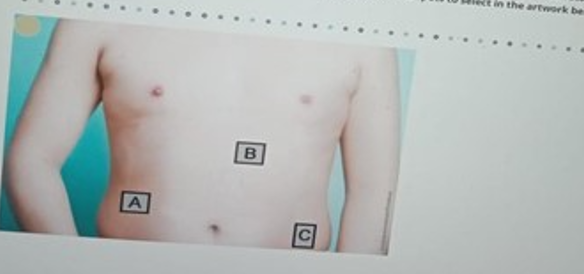A nurse is preparing to receive a client from surgery following a transverse colon resection with colostomy placement. The nurse should expect to assess the stoma at which of the following locations? (You will find hot spots to select in the artwork below. Select only the hot spot that corresponds to your answer.)

A
B
C
None
The Correct Answer is B
The transverse colon is located across the right upper quadrant, epigastrium and the left upper quadrant.
Nursing Test Bank
Naxlex Comprehensive Predictor Exams
Related Questions
Correct Answer is D
Explanation
D. Start an IV with a large-bore needle. Establishing intravenous access is crucial for fluid resuscitation and administering medications. It allows for timely administration of fluids and other necessary treatments to stabilize the client’s condition.
A. Increasing the room temperature is not a priority intervention for a client with a burn injury, especially immediately after securing the airway.
B. While wound care is essential in the management of burn injuries, it is not the first intervention to prioritize after securing the airway.
C. Burn injuries can be extremely painful, and providing analgesic medication is important but not a priority intervention
Correct Answer is {"A":{"answers":"A"},"B":{"answers":"A"},"C":{"answers":"A"},"D":{"answers":"A"},"E":{"answers":"A"},"F":{"answers":"A"},"G":{"answers":"A"}}
Explanation
The client's record indicate that they are experiencing a myocardial infarction due to the elevated markers of inflammation, cardiac biomarkers and typical ECG findings.
Management of myocardial infarction includes oxygen supplementation, nitroglycerin, morphine sulphate, beta blocker such as metoprolol and aspirin/clopidogrel
Among the triggers of myocardial infarction can be cardiac dysrhythmias. This can be caused by electrolytes disturbances and hence the need to draw electrolytes.
Whether you are a student looking to ace your exams or a practicing nurse seeking to enhance your expertise , our nursing education contents will empower you with the confidence and competence to make a difference in the lives of patients and become a respected leader in the healthcare field.
Visit Naxlex, invest in your future and unlock endless possibilities with our unparalleled nursing education contents today
Report Wrong Answer on the Current Question
Do you disagree with the answer? If yes, what is your expected answer? Explain.
Kindly be descriptive with the issue you are facing.
